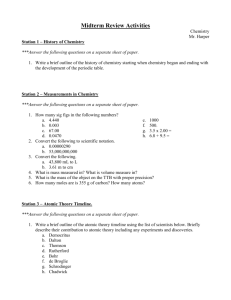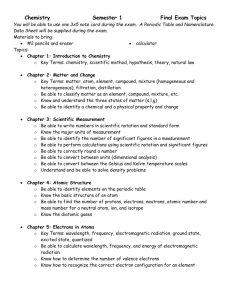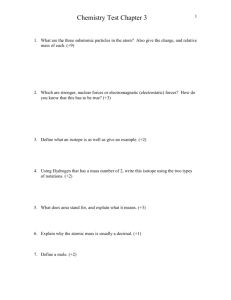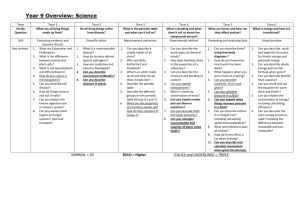Chemistry Final Exam Study Guide
advertisement
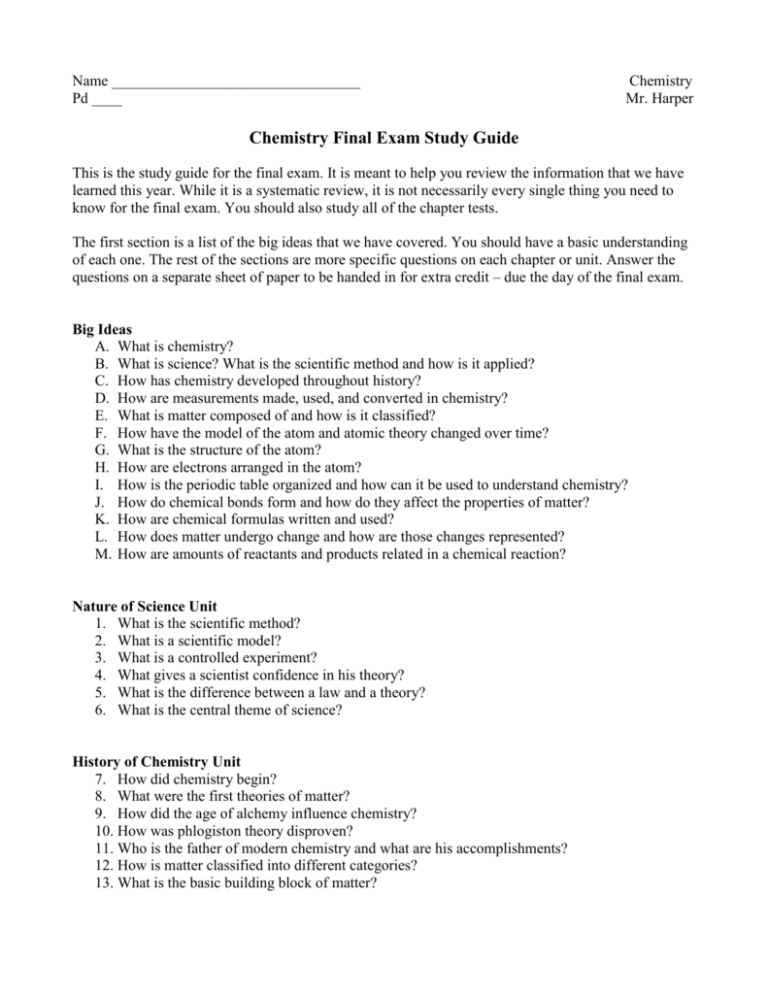
Name _________________________________ Pd ____ Chemistry Mr. Harper Chemistry Final Exam Study Guide This is the study guide for the final exam. It is meant to help you review the information that we have learned this year. While it is a systematic review, it is not necessarily every single thing you need to know for the final exam. You should also study all of the chapter tests. The first section is a list of the big ideas that we have covered. You should have a basic understanding of each one. The rest of the sections are more specific questions on each chapter or unit. Answer the questions on a separate sheet of paper to be handed in for extra credit – due the day of the final exam. Big Ideas A. What is chemistry? B. What is science? What is the scientific method and how is it applied? C. How has chemistry developed throughout history? D. How are measurements made, used, and converted in chemistry? E. What is matter composed of and how is it classified? F. How have the model of the atom and atomic theory changed over time? G. What is the structure of the atom? H. How are electrons arranged in the atom? I. How is the periodic table organized and how can it be used to understand chemistry? J. How do chemical bonds form and how do they affect the properties of matter? K. How are chemical formulas written and used? L. How does matter undergo change and how are those changes represented? M. How are amounts of reactants and products related in a chemical reaction? Nature of Science Unit 1. What is the scientific method? 2. What is a scientific model? 3. What is a controlled experiment? 4. What gives a scientist confidence in his theory? 5. What is the difference between a law and a theory? 6. What is the central theme of science? History of Chemistry Unit 7. How did chemistry begin? 8. What were the first theories of matter? 9. How did the age of alchemy influence chemistry? 10. How was phlogiston theory disproven? 11. Who is the father of modern chemistry and what are his accomplishments? 12. How is matter classified into different categories? 13. What is the basic building block of matter? Measurement Unit 14. How do you keep track of precision in measurements and calculations? 15. How do you correctly read a triple beam balance and a graduated cylinder? 16. Identify how many significant figures in each number. a. 0.0023 ____ c. 2500 ____ e. 34.020 ____ b. 101.0 ____ d. 1000. ____ f. 20,030 ____ 17. Perform the indicated operation and write the answer with the correct significant figures. a. 26.0 x 0.005 = _______ c. 124 – 25.7 = _______ b. 890 / 34.00 = _______ d. 354 + 3.2 = _______ 18. Convert the following quantities. a. 50.6 mL to L b. 14.33 kg to g 19. Write these numbers in scientific notation. a. 1526000 b. 0.000583 20. What is the difference between atomic mass and molar mass? 21. What is the mole? 22. What is Avogadro’s number? 23. Convert 45.0 g of sulfur to moles. 24. Convert 365.0 g of iodine to atoms. CH 3: Atomic Structure 25. What is the atomic number and mass number of an element? 26. What is are the subatomic particles and their properties? 27. What is the structure of the atom? 28. What are isotopes? 29. How many protons, electrons, and neutrons are in the following? a. Carbon-14 b. 816O 30. How did the idea of the atom become a scientific theory? 31. What were the four basic laws of matter that supported the idea of the atom? 32. Who were the major scientists involved in atomic theory and what were each of their contributions to the theory? 33. What are the five major models of the atom? CH 4: Electron Configuration 34. What is the electromagnetic spectrum? 35. How are frequency, wavelength, and energy of light related? 36. What happens when a photon is absorbed or emitted by an atom? 37. What are the energy levels in the atom? 38. What is the letter for each orbital and how many electrons does each hold? 39. What is the electron configuration, noble gas notation, and orbital notation for As? CH 5: Periodic Table 40. How did Mendeleev organize the periodic table & what did it allow him to predict? 41. How is the modern periodic table organized? 42. Why do groups have similar properties? 43. What are the trends in the periodic table? CH 6: Chemical Bonding 44. Fill in the chemical bonding comparison chart below. 45. Why do atoms form chemical bonds? 46. How can the properties of different compounds be explained by the type of bonding and their atomic or molecular structure? 47. What is the electron dot diagram for the bond between magnesium and chlorine? 48. What is the Lewis structure for H2S? What is its geometry, polarity, & intermolecular forces? CH 7: Chemical Compounds 49. What is an ion? What is a polyatomic ion? 50. What is the chemical formula for aluminum sulfide? Barium hydroxide? Dinitrogen pentoxide? 51. What is the name of Fe2O3? (NH4)2CO3? CCl4? 52. How do you know if a substance is an acid? 53. What is the percentage composition of CCl4? 54. A compound is found to be 63.52% iron and 36.48% sulfur. Find the empirical formula. 55. What is the molecular formula of a compound with an empirical formula of C2H5 and a formula mass of 58.14 amu? 56. How many ions are in 550.0 g of sodium bicarbonate? 57. How many moles of oxygen in 10.5 moles of phosphoric acid? CH 8: Chemical Reactions 58. What is a chemical reaction? 59. What are the signs of a chemical reaction? 60. What are the factors that can affect the rate of a reaction? 61. What changes in matter occur during a chemical reaction? 62. What changes in energy can occur during a chemical reaction? 63. Why must you balance a chemical equation? 64. What are the 5 types of chemical reactions and their general equations? 65. How do you use the activity series? 66. How do you determine the states of matter of substances in a chemical reaction? 67. How do you predict the products of a reaction? 68. Acetic acid is mixed with calcium hydroxide. Write the balanced chemical equation, include states of matter, and identify the type of reaction. 69. Methane is burned in air. Write the balanced chemical equation, include states of matter, and identify the type of reaction. CH 9: Stoichiometry 70. How do you convert between moles or grams of reactants to moles or grams of products? 71. How do you determine the limiting reactant in a chemical reaction? 72. How do you determine the actual yield of a product given the percentage yield? Chemical Bonding Comparison Characteristic or property Types of elements (metals, nonmetals) Basic unit of compound (molecule, formula unit, atom) Components of compound (atoms w/ shared electrons, ions, atoms w/ free electrons) Structure of compound (crystal lattice or individual molecules) Behavior of electrons (shared, free, lost/gained) Measurement of bond strength (lattice energy, enthalpy of vaporization, bond energy) Relative melting point (high, low, medium) Typical water solubility (Yes, No, Depends on polarity) Solid conductivity (Yes, No) Aqueous conductivity (Yes, No, N/A) Other properties: (e.g. Hard, brittle, malleable, ductile, weak intermolecular forces) Example: Name and chemical formula Model: Draw a representation of each compound. (Use back of sheet if necessary.) Ionic Metallic Covalent Molecular Network
